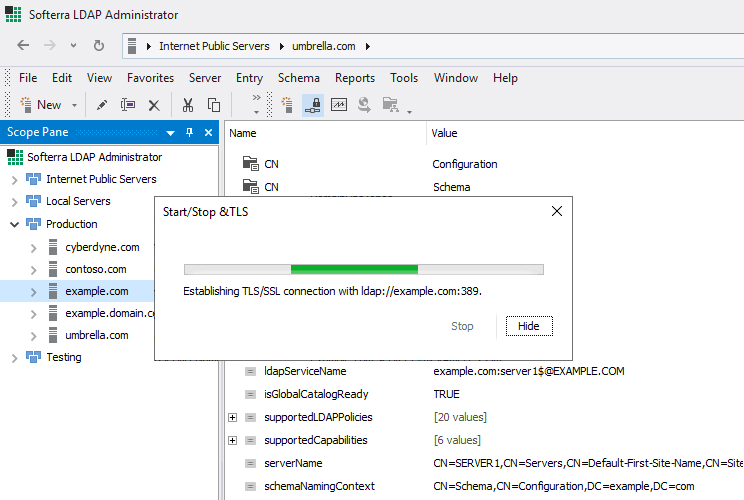Features
LDAP server support
Work with several servers at once, organize them in groups, and easily copy data between them. LDAP Administrator supports LDAPv2 and LDAPv3 protocols and allows working with OpenLDAP, Netscape/iPlanet, Novell eDirectory, Oracle Internet Directory, Lotus Domino, Microsoft Active Directory, CA Directory, Siemens DirX, and any other LDAP server.
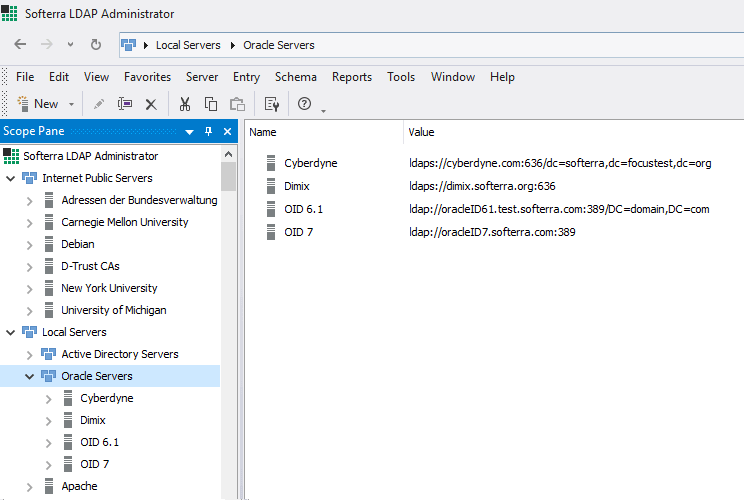
Efficient navigation
Set various LDAP filters to display only the entries that match your criteria. Quickly access frequently viewed branches by setting a custom base DN to start browsing from. Jump to previously viewed objects using navigation history. And much more.
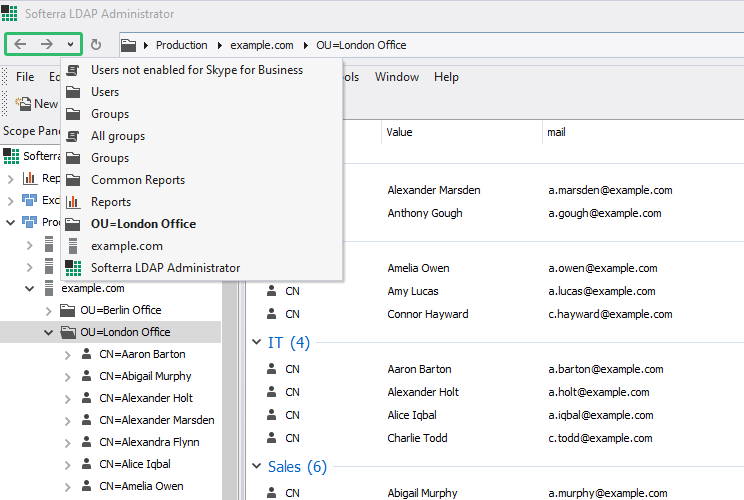
VLV and simple paging support
Use the specially crafted Virtual List View (VLV) and simple paged result controls to retrieve only the entries you need, without waiting for thousands of records to load.
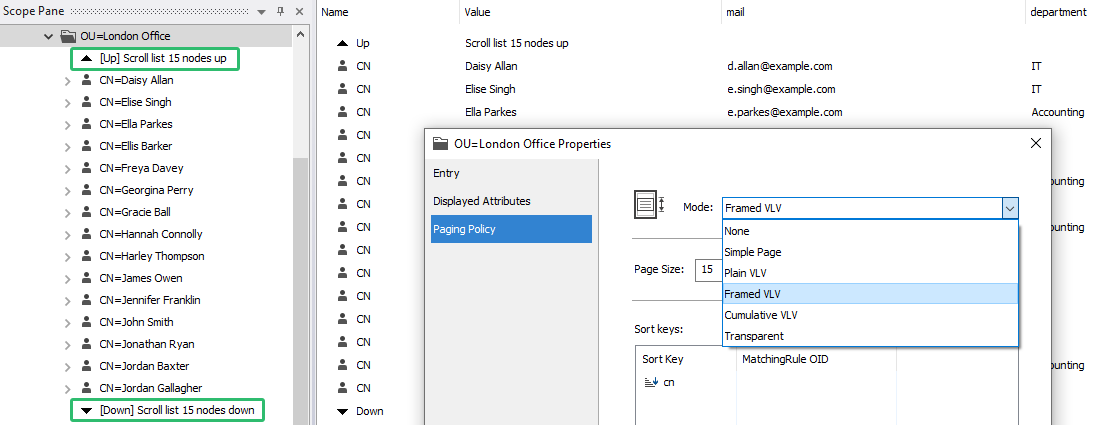
HTML view
View LDAP entries in a user friendly manner, represented as an HTML page. You can also customize the way the information is displayed. For example, if you don't want some attributes to be displayed for objects of a specific type, you can remove these attributes from the corresponding HTML page template.
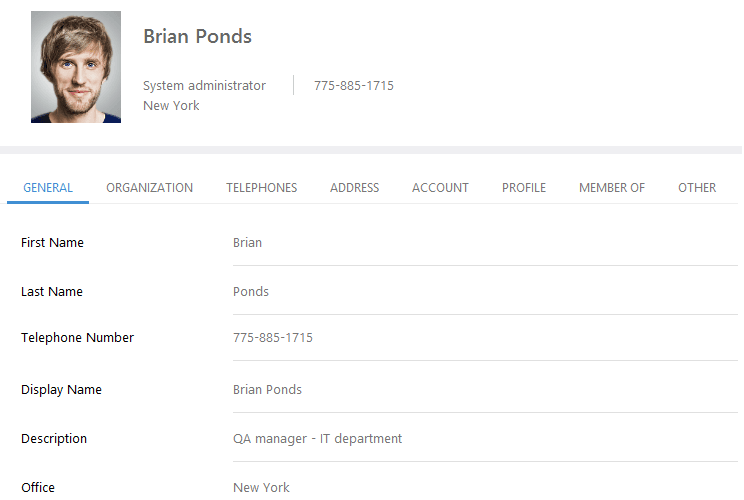
Read-only server profile
Prevent directory data from being accidentally modified or deleted by making your LDAP server profiles read-only in LDAP Administrator.
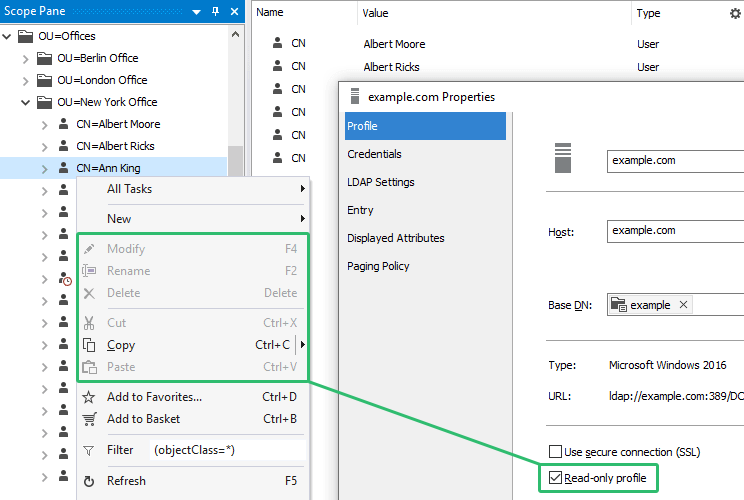
LDAP referrals support
LDAP Administrator fully supports LDAP referrals and provides several modes for handling them.

Template-based entry creation
The template-based method allows you to create new entries quickly and easily, based on the templates with predefined lists of required and optional attributes. This method is very helpful if you often need to create multiple entries with a similar set of attributes.
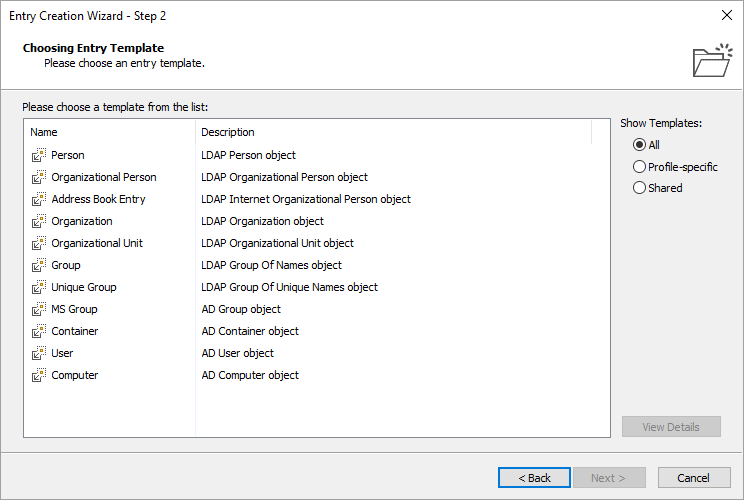
Bulk object modification
Modify multiple objects simultaneously, wherever they are located. Simply search for objects that fit your criteria, select them, and modify them in bulk. You also have a basket that helps perform bulk operations on unrelated objects, for example, entries from different subtrees or LDAP servers.
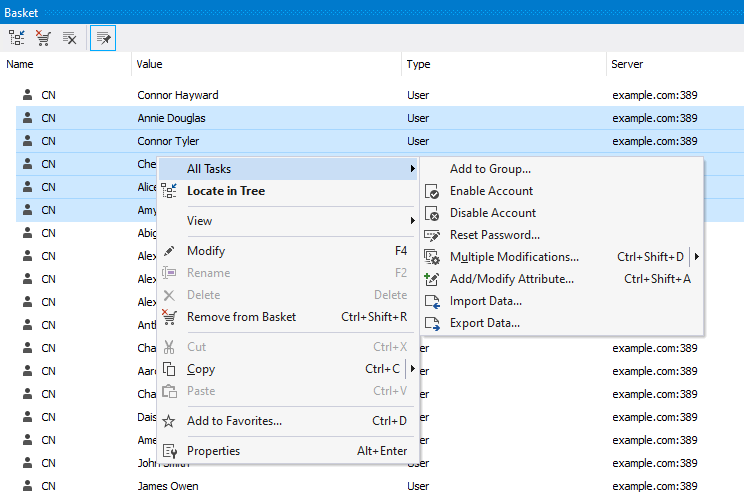
Streamlined object handling
Move and copy LDAP objects using Windows clipboard, or just drag-and-drop them. Quickly copy object DNs, RDNs, LDAP URLs, or copy the entire entry data in LDIF, DSMLv1, DSMLv2, and CSV formats. Rename objects with a handy RDN editor, regardless of whether the RDN is single or multi-vaued. Add or remove object classes on the fly using a convenient wizard. And much more.

Attribute editors
LDAP Administrator provides various attribute value editors strictly associated with attribute type and syntax that allow you to easily modify binary, password, date and time attributes, and also manage attributes that store combinations of flags, files, images and many other well-known attributes.
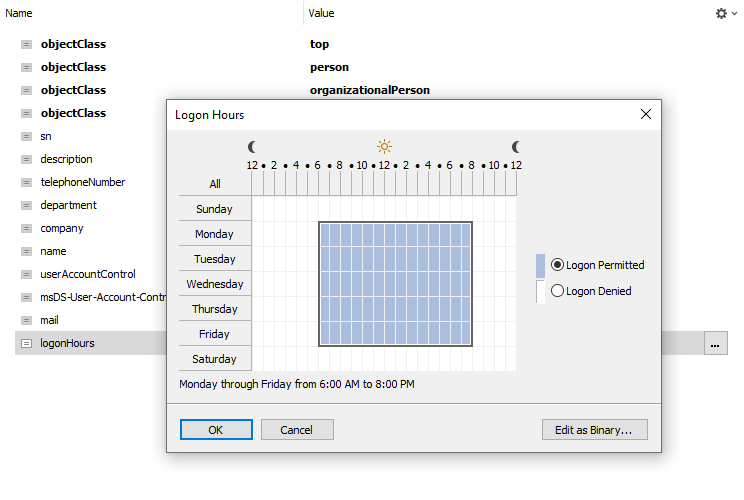
Attribute value references
Value references allow you to generate attribute values based on other attribute values of the object. For example, you can update several objects in bulk, and generate values for their mail attribute from their unique user UIDs and a constant domain name.
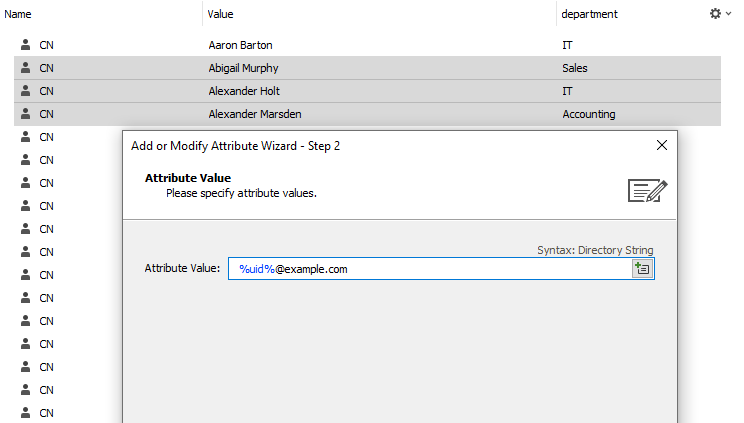
LDAP request log
The LDAP request log keeps track of all LDAP requests sent by LDAP Administrator and the responses received from the server. It lets you monitor the interaction between LDAP Administrator and your servers on a more detailed level, track errors, and much more. The information is presented in LDIF or DSML2 format, which allows importing log data directly to the server.
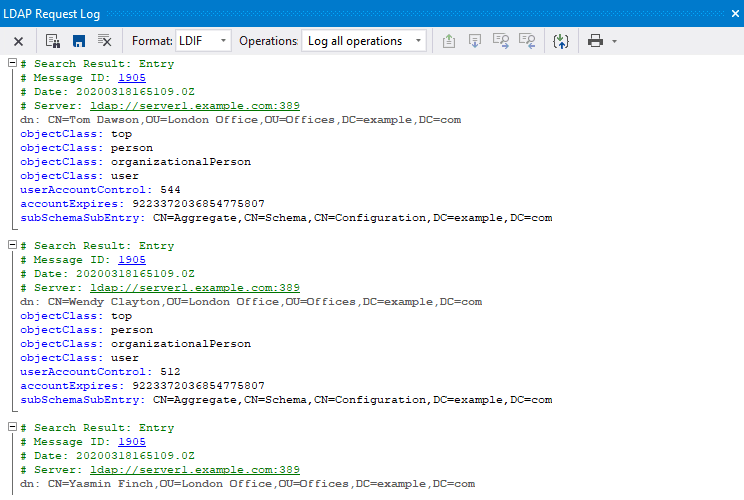
Auxiliary tools
LDAP Administrator is complemented by features like LDAP Server Monitor, AD Application Partition Manager, LDAP Schema Viewer, that let you view various advanced information about your LDAP server. For example, the Server Monitor enables you to check server statistics like server version, server uptime information, number of current connections, number of initialized operations, number of entries sent to clients, etc.
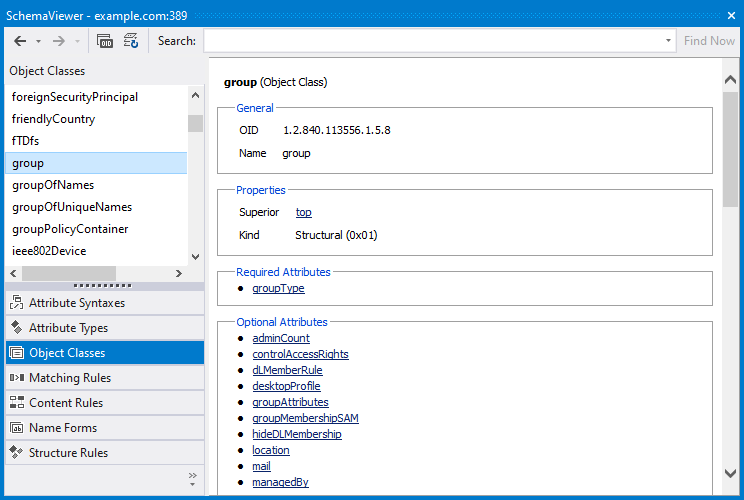
ManageDsaIT control support
The ManageDsaIT control lets you work with referral objects just like with normal entries, allowing you to view and modify them.

Powerful directory search
Search the directory quickly and efficiently using many different search options offered by LDAP Administrator. Search results can be handled just like the entries in the directory tree – you can modify them in bulk, export to a file, etc.
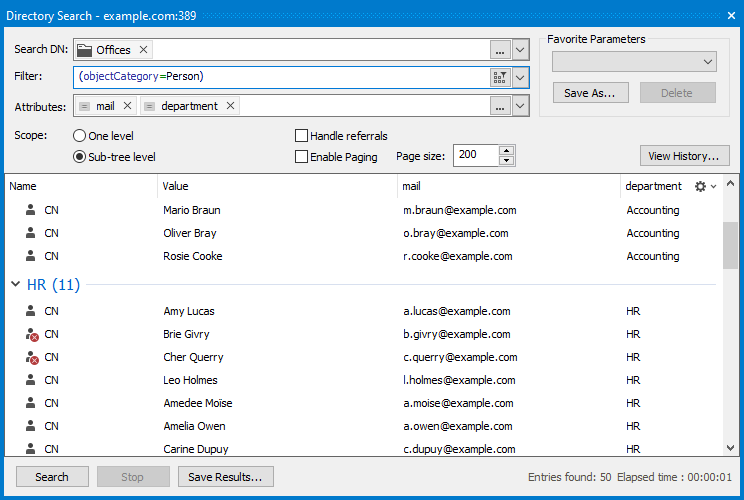
Quick search
Quick search lets you instantly find a directory object by typing a keyword or a phrase that is a part of its attribute values. Intelligent autocompletion will suggest relevant objects while you are still typing.

LDAP-SQL search
Search the directory using the SQL syntax. With LDAP-SQL, you can execute searches that cannot be done using standard LDAP search methods. For example, you can use LDAP attribute values as search filter parameters.
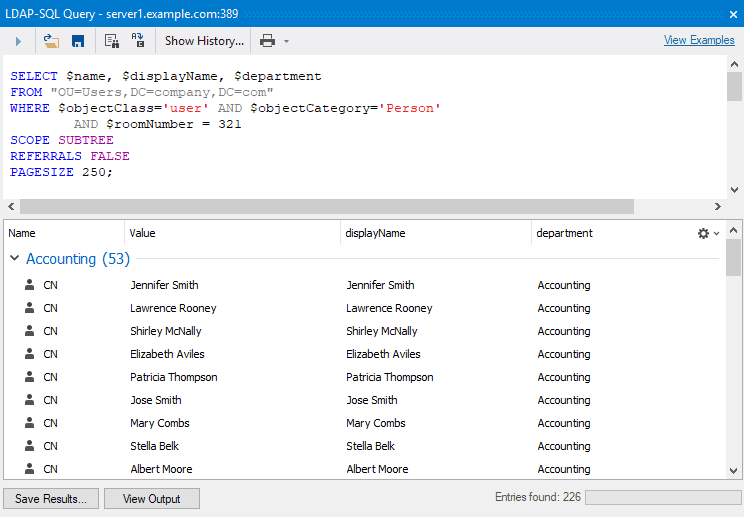
LDAP filter builder
Simplify the creation of LDAP search filters and save them for later usage with the help of LDAP Filter Builder. LDAP Filter Builder provides Intellisense, drag'n'drop, undo/redo, filter verification, and other features to streamline filter creation.
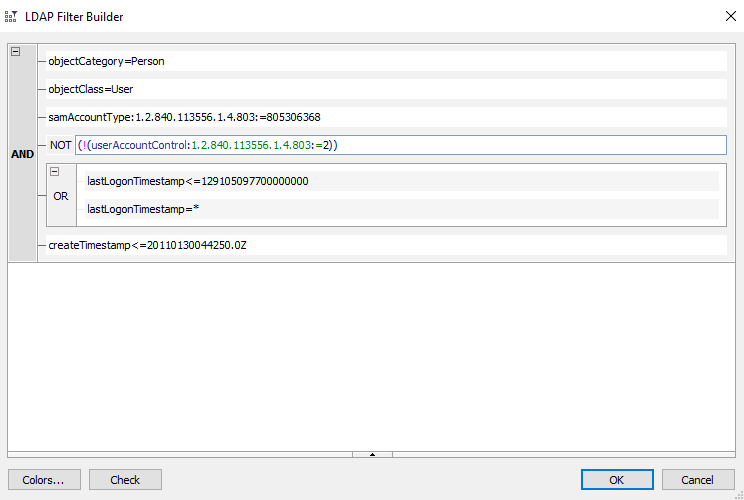
Search history
Every search made with the Directory Search tool is recorded in history. Quickly find and restore previous searches, pin frequently-used searches, and much more.
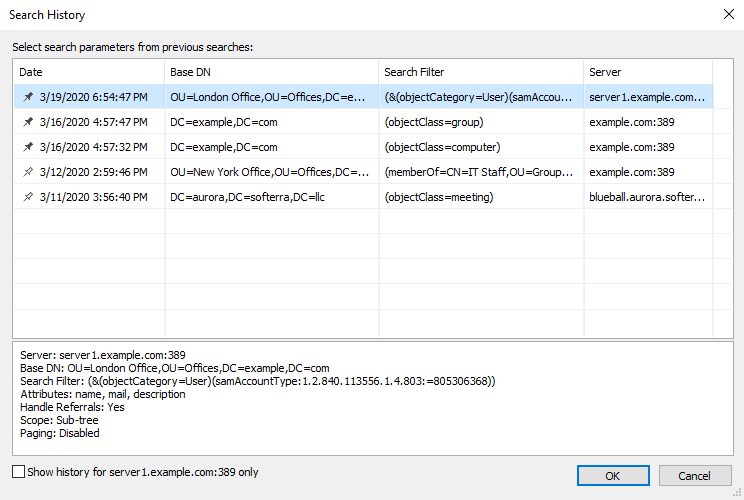
Data export
LDAP Administrator lets you easily transfer or back up directory information by exporting it to a file in LDIF, DSMLv1, DSMLv2, MS Excel, CSV, Plain Text, or HTML format. Both, export of individual records and bulk export are possible.
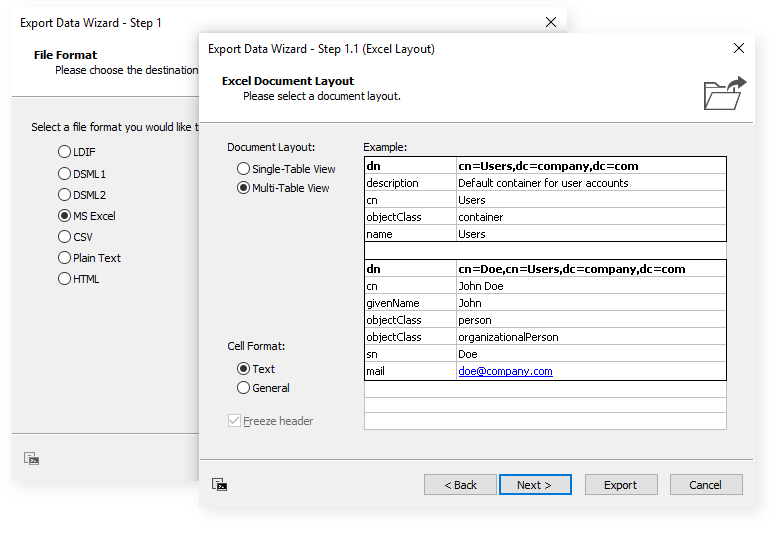
Data import
LDAP Administrator provides handy wizards that enable data import from LDIF, DSMLv1, DSMLv2, and CSV files to your directory.
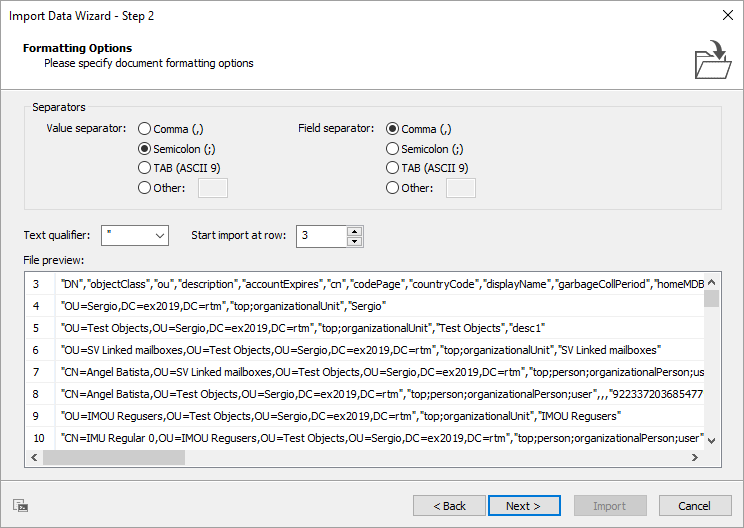
LDAP import/export from command line
The laimex tool supplied with LDAP Administrator enables you to import/export directory data in an unattended mode. Great for automating LDIF import operations and daily directory backups.
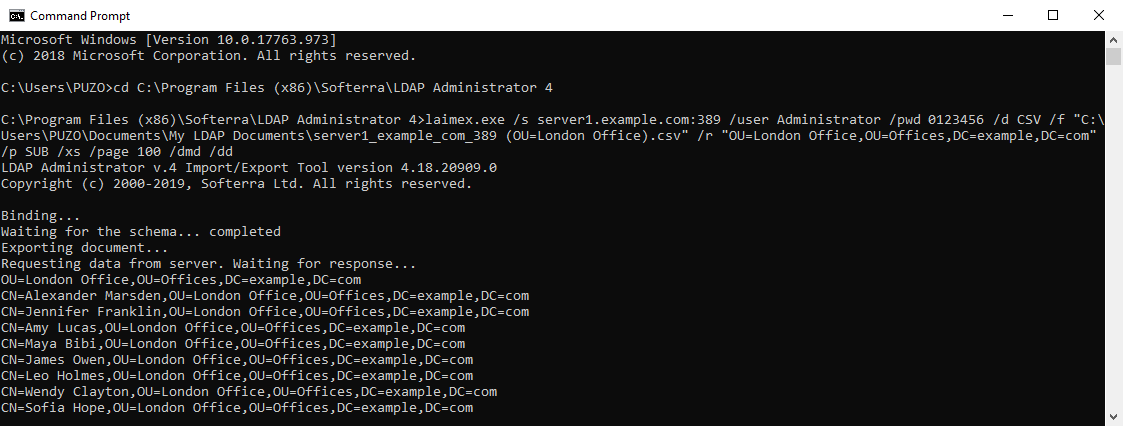
LDAP Administrator allows you to use SQL syntax to work with LDAP servers. Using the typical SQL commands like SELECT, INSERT, UPDATE, and DELETE, you can perform searches as well as create, modify, and delete entries and attributes in LDAP directories.
Advanced SQL search
Perform search requests that cannot be executed via standard LDAP means. Use LDAP attribute values as criteria for search filters. For example, you can find all users whose displayName attribute equals their cn attribute.
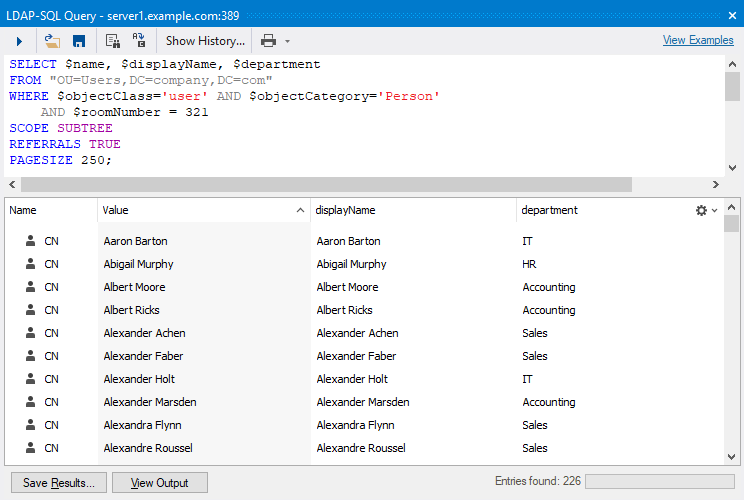
SQL editor
SQL editor is a powerful tool for creating and editing SQL expressions. It offers syntax highlighting, context IntelliSense, undo/redo operations, outlining and other useful IDE features that significantly simplify the creation of SQL queries.
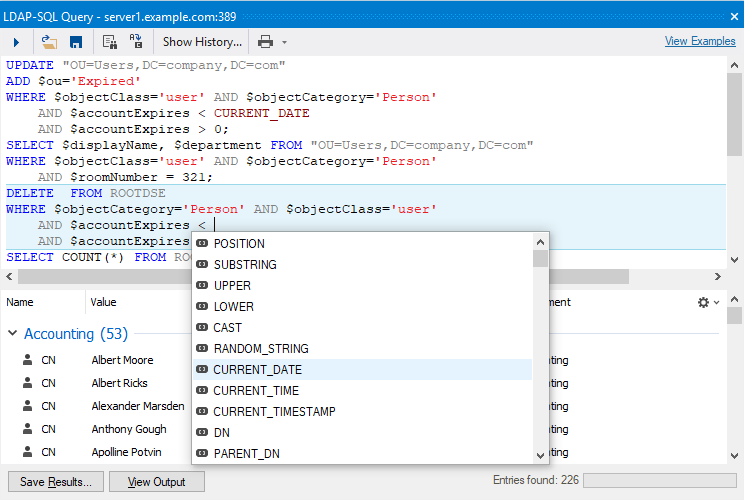
Bulk update/delete
Bulk update or delete LDAP entries that meet your specific conditions. For example, you can easily delete all directory users, whose accounts have expired.
Compose attribute values using the values of other attributes. For example, to set unique emails for several users, you can specify the mail attribute value as the user's own UID, and add a constant domain name.

Built-in SQL functions
LDAP-SQL provides many built-in functions that you can use in queries to find or perform operations on LDAP entries. For example, you can create a query to find all users whose accounts expire in one month using the CURRENT_DATE function and the interval type.

SQL output
SQL Output pane provides detailed information about the execution of SQL statements, displays syntax and runtime errors, and allows to quickly locate errors in the code.
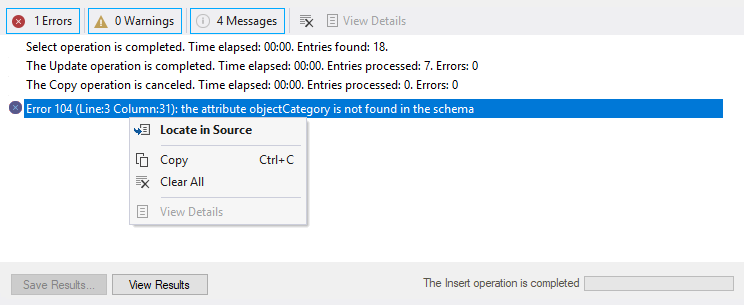
Directory reports provided by LDAP Administrator facilitate the analysis and monitoring of LDAP directories and provide you with important information on their organization. Using reports, you can instantly find specific object types, view recently modified directory objects, find all objects with a specific account status, etc.
Out-of-the-box reports
LDAP Administrator offers a large number of out-of-the-box reports, which provide information about widely used directory objects such as Users, Computers, Groups, Organizational Units, POSIX Accounts, etc.
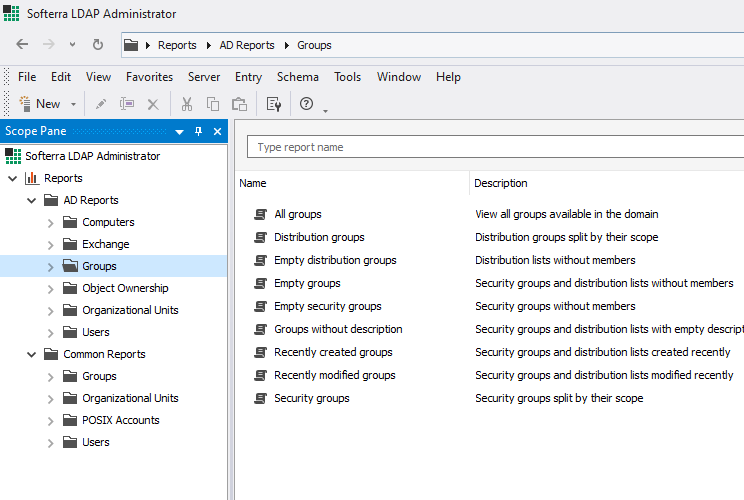
Creating custom reports
Though LDAP Administrator provides a wide range of ready-to-use reports, sometimes you might need a report that is not on the list. For this purpose, LDAP Administrator gives you the possibility to create absolutely new reports or customize the existing ones.
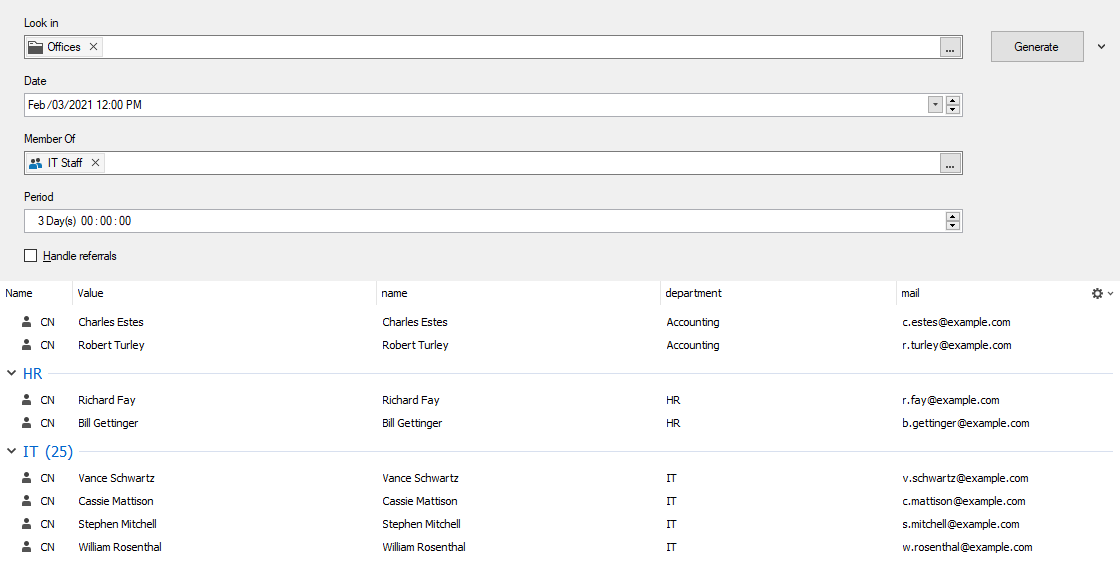
Working with report results
After a report is generated, you can manage its results in the same way you manage usual LDAP entries: modify them in bulk or export to formats like LDIF, DSMLv1, DSMLv2, CSV, Excel, Plain Text, and HTML. Any search result can also be quickly located in the directory tree.
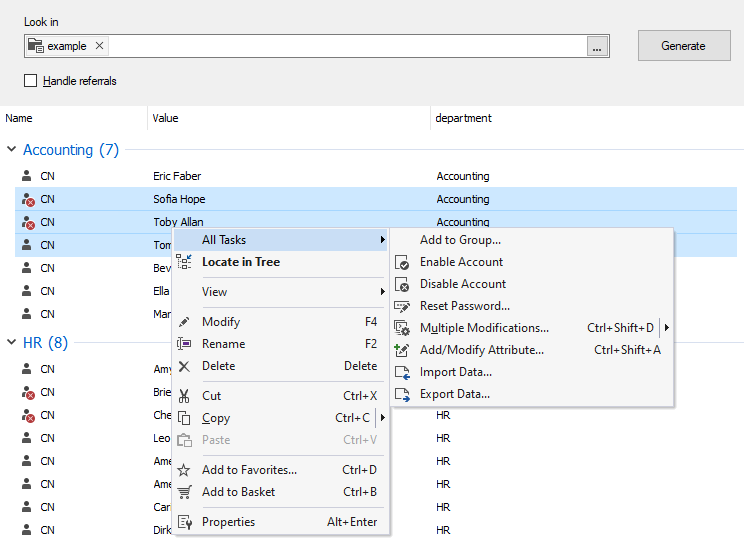
Quick LDIF navigation
View and modify LDIF documents in the form of a directory tree, as if they were physically located on the server. Instantly find LDIF records in the current document – just start typing in the navigation box to display items that contain the typed text.

Intelligent formatting
LDIF editor offers syntax highlighting, IntelliSense, text outlining, and other features that make working with LDIF files a walk in the park. You can quickly obtain information on the structure and the content of an LDIF file, and easily work with files that contain a large number of records.
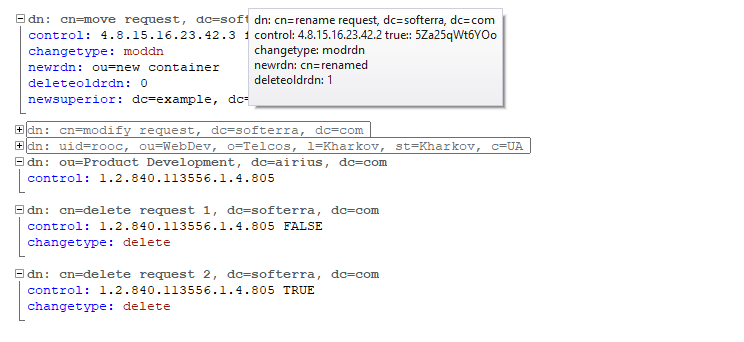
LDIF file import
Instantly import data from the current file to the directory. Just grab this option from the toolbar and select a server where you want to import the data.
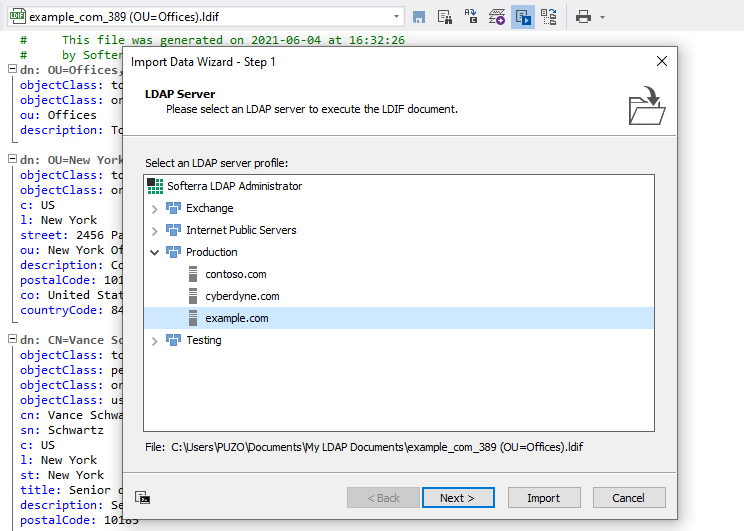
Convenient attribute editors
LDIF Editor provides you with built-in attribute editors, e.g. a binary editor to modify binary data and insert them into the document in the Base64 format, a password editor, a GUID editor, etc.
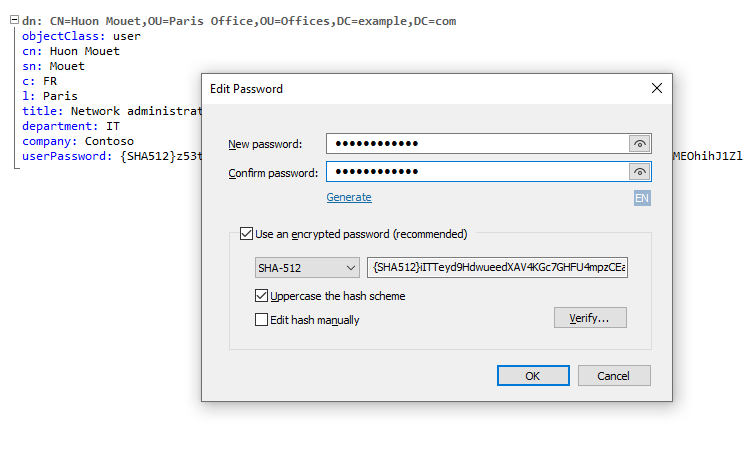
Regular expression support
LDIF editor lets you use regular expressions – a powerful and flexible text processing method for search and replace operations.
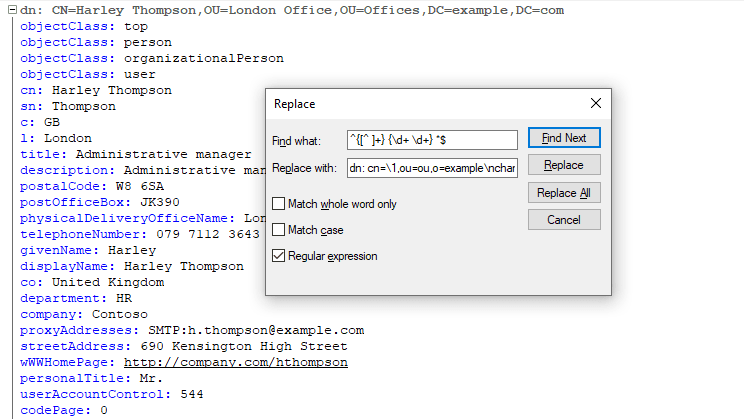
Advanced methods of LDAP authentication
LDAP Administrator supports the most popular secure and non-secure LDAP authentication mechanisms, and ensures safe communication with any LDAP server.
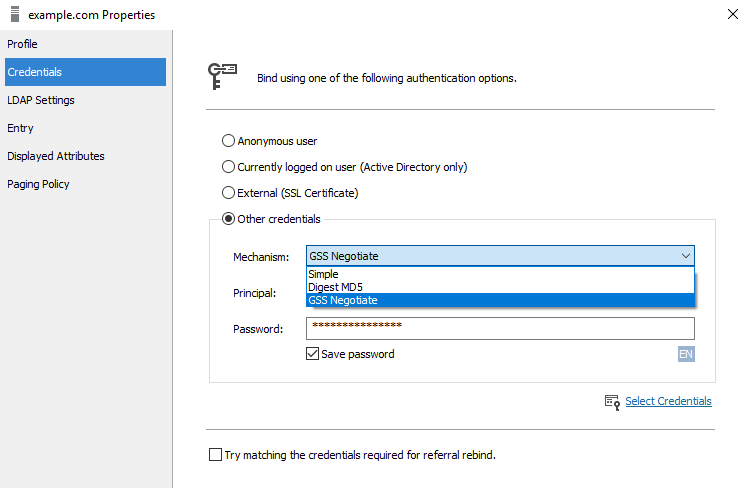
Credentials manager
LDAP Administrator has an integrated credentials manager that can securely store the credentials for accessing LDAP servers. Gone are the days of entering the credentials over and over every time you bind to your servers.
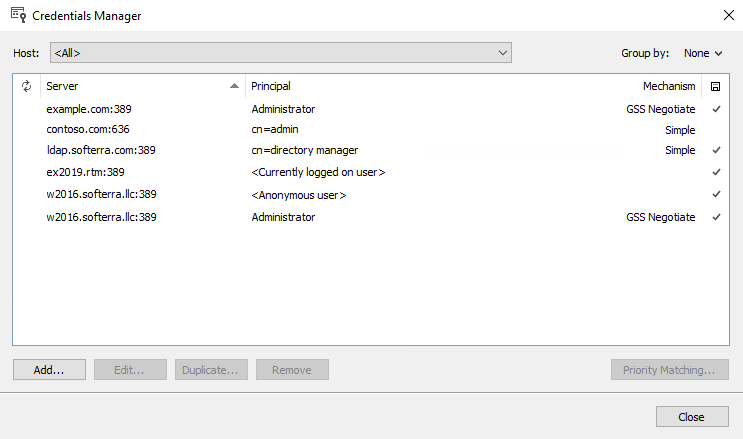
Secure SSL connection
Establish secure SSL connections with your LDAP servers to ensure that all transferred data is encrypted and protected.
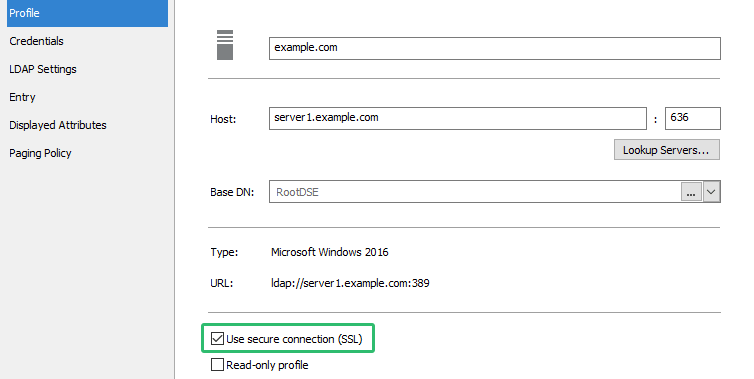
Transport Layer Security
Encrypt communications between LDAP Administrator and LDAP servers using Transport Layer Security (TLS), to safely perform encrypted operations during nonsecure sessions.
